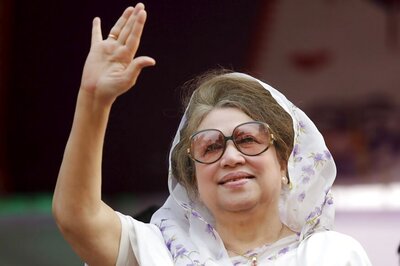
views
Political fraternity in Uttar Pradesh is intrigued over Prime Minister Narendra Modi’s decision to launch the ambitious Pradhan Mantri Kisan Samman Nidhi (PM-KISAN) scheme from Gorakhpur in eastern Uttar Pradesh.
This was not the first time that Modi chose Uttar Pradesh to launch a centrally sponsored scheme. Modi had launched the Pradhan Mantri Ujjwala Yojana (PMUY) in Ballia in May 2016 ahead of the UP Assembly elections. The most common reason cited is the BJP’s electoral setback in Madhya Pradesh, Chhattisgarh and Rajasthan. The ruling NDA is desperate to address the grievances of farmers before the 2019 Lok Sabha elections.
Gorakhpur is the same place where Narendra Modi, in the run-up to the 2014 elections had dared then Samajwadi Party chief Mulayam Singh Yadav that “one needs 56-inch chest” to fulfil the task of “developing Uttar Pradesh like Gujarat”.
The reasons for why Modi chose Gorakhpur to launch Kisan scheme are not far to seek. The choice is significant because in the Gorakhpur parliamentary bypoll in March 2018, the BJP lost to a Nishad party candidate supported by the Samajwadi Party and the Bahujan Samaj Party. The loss of Gorakhpur was significant as this seat was vacated by Uttar Pradesh Chief Minister Yogi Adityanath. The bypoll was the first electoral test for the SP-BSP alliance against the BJP in the state.
In the secular parlance of Uttar Pradesh politics, Gorakhpur is identified as the “communal cauldron” which elected the saint-turned-rabble rouser Yogi Adityanath, the head of the Goraknath Peeth, as Lok Sabha MP for five consecutive times from 1998 to 2014.
As the seat proves to be a prestige battle for Yogi Adityanath, Sanjay Nishad, president of the Nishad party, has posed an additional challenge to the BJP by announcing that he will contest from the neighbouring Maharajganj Lok Sabha seat.
Moreover, Narendra Modi is MP from neighbouring Varanasi constituency, less than 200 km from Gorakhpur. Samajwadi party patriarch Mulayam Singh Yadav is MP from another important neighbouring constituency, Azamgarh, which is 100 km from Gorakhpur.
In 2014 elections, lot of political significance was attributed to Mulayam Singh Yadav’s candidature from Azamgarh. It was argued that Mulayam would will be the secular bulwark to halt the BJP’s juggernaut in eastern UP. Of the total 41 Lok Sabha seats in eastern UP, barring Amethi, Raebareli and Azamgarh, the BJP swept the elections in the rest of the 38 seats. This time, Mulayam has already announced that he would shift to his traditional Mainpuri Lok Sabha seat, thus making the battle rather easy for the BJP in Azamgarh. Ramakant Yadav of the BJP had won Azamgarh seat in 2009 Lok Sabha polls.
As per the seat-sharing formula reached between the Samajwadi Party and the BSP, the former will contest on the bulk of the seats in eastern UP. The BJP in Uttar Pradesh is already head and shoulder above rivals like the Samajwadi Party and BSP in preparations for the Lok Sabha polls. Both the parties were seen short of credible political narrative to debunk the PM-KISAN scheme.
BSP chief Mayawati borrowed a leaf from the Congress’s book, saying annual pay-out of Rs 6,000 to the farmers translated to Rs 500 per month or Rs 17 per day. Congress chief Rahul Gandhi had levelled similar criticism at the PM–KISAN scheme on February 1, the day Piyush Goyal presented the budget in Parliament.
SP chief Akhilesh Yadav chose Twitter to run down the budget speech. “The farm crisis is a national crisis and needs a national solution. No poll sop or individual state can implement change at this scale. We stand with farmers everywhere and promise to bring about a #GoldenRevolution for all farmers regardless of caste, creed or religion," Yadav tweeted.
Last but not the least, Priyanka Gandhi Vadra is the Congress general secretary in-charge of eastern Uttar Pradesh. She is yet to visit the areas in her jurisdiction, but the unease is visible in the three major political contenders in UP — the BJP, Samajwadi Party and the BSP.
Priyanka Gandhi had arrived in Lucknow on February 10 on her maiden visit since joining politics. The same day, a ‘core group’ comprising top leaders of the state BJP headed by Yogi Adityanath went into a huddle. The next day, the citizens of Lucknow opened their newspapers to see full page advertisements announcing that Uttar Pradesh has made rapid strides in all spheres of development and was number one in all-India ranking in field of food grains production, dairy etc. Though there was no political context or occasion for the splashy advertisement, the reason was obvious — to prevent Priyanka Gandhi from hogging the headlines.
BJP leaders do not see anything unusual in the government’s decision to launch the PM-Kisan scheme from Gorakhpur. “It makes sense because the programme is for marginal farmers and Uttar Pradesh has the maximum number of small farmers in the country. Politically also, UP sends the maximum number of MPs to the Lok Sabha. Obviously, the state is important for the BJP," said UP agriculture minister Surya Pratap Shahi.
Uttar Pradesh holds the key for the BJP to win the 2019 elections and return to power. It was UP that catapulted the BJP to the throne of Delhi in 2014. The BJP had won 71 seats and two seats had gone to its ally Apna Dal, helping the saffron party cross the halfway mark in the Lok Sabha.
(Author is a senior journalist. Views are personal)

















Comments
0 comment